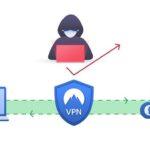As Windows browsers like Chrome and Edge tightened anti-phishing protections in 2024, cybercriminals shifted focus to a new target: Mac users. A surge in sophisticated Apple ID phishing scams in early 2025 has left thousands vulnerable to account takeovers, financial fraud, and data theft. This guide breaks down how these new Apple password attack work, red flags to watch for, and actionable steps to safeguard your Apple ecosystem.
3 VPNs That Pass All Tests in 2025
- NordVPN: Unmatched security for high-risk users.
- Surfshark: Budget-friendly pick for unlimited devices.
- ExpressVPN: Speed king for buffer-free streaming.
Why Mac Users Are Now in the Crosshairs
1. The Windows Security Ripple Effect
- Improved Windows Defenses: AI-powered browser filters reduced phishing success rates on Windows by 40% in 2024 (Cybersecurity Ventures).
- Macs: A Lucrative Alternative: 23% growth in Mac adoption since 2023 (StatCounter) made Apple IDs a high-value target.
2. Exploiting Apple’s Ecosystem Trust
- iCloud Reliance: Hackers mimic Apple’s seamless design to trick users into sharing credentials.
- Cross-Device Access: Compromising an Apple ID grants access to iPhones, iPads, and Macs.
How the 2025 Apple ID Phishing Scam Works
Step 1: The Bait
- Fake “Security Alerts”: Emails/SMS claiming suspicious activity on your Apple ID.
- iCloud Storage Lures: “Your iCloud is full—verify account to avoid data loss.”
- Billing Scams: “Update payment method to keep services active.”
Step 2: The Trap
- Cloned Apple Pages: Nearly identical copies of Apple’s sign-in or billing pages.
- 2FA Bypass: Scammers use real-time proxies to intercept one-time codes.
Step 3: The Payoff
- Account Takeover: Stolen credentials unlock iCloud, App Store, and device access.
- Financial Fraud: Stored credit cards exploited for unauthorized purchases.
Real-World Impact: A March 2025 campaign spoofed Apple Support, draining $1.2M from victims (FBI IC3 Report).
 —————Recommendations; Please continue reading below————— Space-saving Furniture Shop Now
—————Recommendations; Please continue reading below————— Space-saving Furniture Shop Now
If you want to maximise space in your home, office or home-office with flexible furniture that collapses, folds, and stacks to fit every room, you can click here to see the wide range of space-saving furniture. Click here to learn more >>>
Choosing the best antivirus for Android in 2025 is critical to safeguarding your data, privacy, and device performance. This updated guide reviews the latest top-rated apps, compares free vs. premium tools, and answers pressing security questions to help you stay ahead of hackers.
5 Red Flags to Spot Apple Phishing Attempts
- Mismatched URLs: Hover over links—legit Apple domains always use “apple.com” or “icloud.com.”
- Urgent Language: “Your account will be locked in 24 hours!”
- Generic Greetings: “Dear User” instead of your name.
- Unusual Sender Addresses: “support@apple-security.org” (vs. “@apple.com”).
- Requests for 2FA Codes: Apple never asks for these via email/SMS.
Free Tool: PhishFinder (browser extension) scans emails for spoofed links.

What to Do If You’ve Fallen Victim
- Revoke Access: Go to Apple ID Settings > “Sign out of all devices.”
- Reset Password: Use a trusted device to create a new, unique password.
- Check Financial Activity: Review App Store/iCloud billing for unauthorized charges.
- Enable Advanced Data Protection: Turn on end-to-end encryption for iCloud backups.
- Report the Scam: Forward phishing emails to Apple at reportphishing@apple.com.
How to Protect Your Apple ID in 2025
1. Use Hardware Security Keys
- 2025 Apple Update: Support for FIDO2 keys like YubiKey 6.
- Setup: Add 2+ keys under Apple ID > Security.
2. Enable Advanced 2FA
- Avoid SMS: Use authenticator apps (e.g., Raivo OTP for iOS/macOS).
- Device-Based Approvals: Require a trusted device for sign-ins.
3. Audit Third-Party App Access
- Remove unused apps under Apple ID > “Sign in with Apple.”
Free Tool: Mozilla Monitor scans data breaches for your Apple ID.
Free Tools to Fortify Your Mac Against Phishing
- Malwarebytes for Mac: Blocks phishing sites and malware (free version available).
- Bitwarden: Securely store passwords; auto-fill only on legit Apple sites.
- Guardian Firewall: Monitors network traffic for suspicious activity.
- Safari Privacy Report: Reveals trackers and attempted phishing domains.
Apple’s 2025 Security Updates to Combat Phishing
- Lockdown Mode 2.0: Hardens Macs against zero-click exploits.
- Safari AI Sandbox: Isolates tabs to prevent credential theft.
- iCloud Alias Emails: Generate disposable emails for app sign-ups.
FAQs: Apple ID Phishing Scams
Q1: Can hackers access my Mac if they have my Apple ID?
Yes. They can remotely lock devices, erase data, or access iCloud Keychain passwords.
Q2: Are iPhone users at risk too?
Absolutely. Phishing scams target all Apple IDs, regardless of device.
Q3: Does Apple reimburse stolen funds?
Rarely. Report to your bank immediately for chargebacks.
Q4: Is “Sign in with Apple” safe?
Yes—it masks your email, but only use it with trusted apps.
The Bottom Line: Stay Vigilant from New Apple Password Attack
As phishing tactics evolve, Mac users can no longer rely on the myth of “Apple immunity.” By combining Apple’s built-in tools with third-party safeguards, you can mitigate risks without sacrificing convenience.
Next Steps:
- Bookmark Apple’s official security page.
- Share this guide with friends/family.
- Schedule a monthly Apple ID security checkup.
Now loading...






